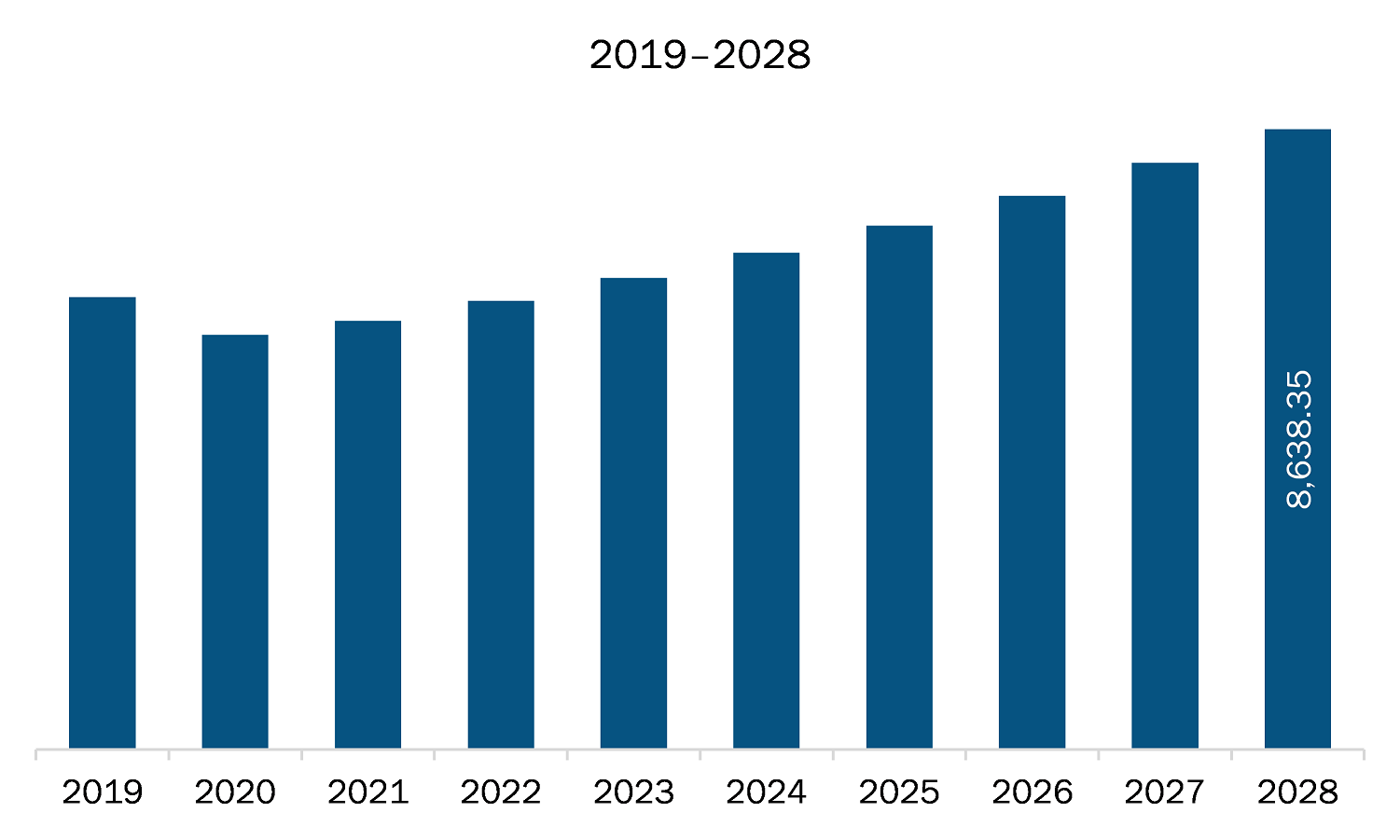The sparkling wine market in APAC is expected to grow from US$ 5,970.39 million in 2021 to US$ 8,638.35 million by 2028; it is estimated to grow at a CAGR of 5.4% from 2021 to 2028.
Australia, China, India, Japan, South Korea are major economies in APAC. The increasing practice of consuming vintage wine on special occasions and surge in the acceptance of wine are the key factors supporting the expansion of the sparkling wines market in developing economies such as India. For instance, wine consumption in China has risen steadily in the 21st century due to high popularity and availability of sparkling wine varieties, especial through online retail channels. The country is also scaling up its domestic wine production. Its vineyard acreage more than doubled during 2006–2016. While most of that land is being utilized for growing table grapes, wine production is gradually increasing. Moreover, international winemakers are seeking entry into the market, and they are altering their winemaking styles and adjusting their packaging designs to appeal to the local consumers. The rising consumption of grape wine is also providing opportunities for the local manufacturers in China. In India, people have started adopting the western tradition of popping champagne corks on special events such as completing new deals, earning large profits, corporate parties, and weddings and receptions. This has resulted in the expansion of the sparkling wine market in the country. Thus, developing countries are providing enormous opportunities for the sparkling wines market players across APAC.
The outbreak of COVID-19 is wreaking havoc on the economic growth of Asia-Pacific. The severity of the consequences and impact is entirely dependent on the transmission of the novel coronavirus. Various governments in Asia Pacific have taken actions to limit the spread by imposing lockdowns, which is slowing down the operations of various industries in the region. This factor is anticipated to severely affect the growth of the regional market. However, with increasing recovery rates, governments are easing the restrictions imposed on various industrial operations, which is expected to create a positive impact for the growth of sparkling wines market across the region.
With the new features and technologies, vendors can attract new customers and expand their footprints in emerging markets. This factor is likely to drive the sparkling wine market. The APAC sparkling wine market is expected to grow at a good CAGR during the forecast period.

- This FREE sample will include data analysis, ranging from market trends to estimates and forecasts.
APAC Sparkling Wine Market Segmentation
APAC Sparkling Wine Market – By Type
- White
- Red
- Rose
APAC Sparkling Wine Market – By Packaging Type
- Bottles
- Cans
APAC Sparkling Wine Market – By Distribution Channel
- Supermarkets and Hypermarkets
- Specialty Stores
- Online Retail
- Others
APAC Sparkling Wine Market- By Country
- Australia
- China
- India
- Japan
- South Korea
- Rest of Asia Pacific
APAC Sparkling Wine Market-Companies Mentioned
- Bacardi and Company Limited
- Casella
- Chandon
- Constellation Brands, Inc.
- Henkell Freixenet
- Pernod Ricard Winemakers
- Treasury Wine Estates Ltd
Asia Pacific Sparkling Wine Report Scope
| Report Attribute | Details |
|---|---|
| Market size in 2021 | US$ 5,970.39 Million |
| Market Size by 2028 | US$ 8,638.35 Million |
| CAGR (2021 - 2028) | 5.4% |
| Historical Data | 2019-2020 |
| Forecast period | 2022-2028 |
| Segments Covered |
By Type
|
| Regions and Countries Covered |
Asia-Pacific
|
| Market leaders and key company profiles |
|
- Historical Analysis (2 Years), Base Year, Forecast (7 Years) with CAGR
- PEST and SWOT Analysis
- Market Size Value / Volume - Regional, Country
- Industry and Competitive Landscape
- Excel Dataset
Recent Reports
Testimonials
Reason to Buy
- Informed Decision-Making
- Understanding Market Dynamics
- Competitive Analysis
- Identifying Emerging Markets
- Customer Insights
- Market Forecasts
- Risk Mitigation
- Boosting Operational Efficiency
- Strategic Planning
- Investment Justification
- Tracking Industry Innovations
- Aligning with Regulatory Trends





















 Get Free Sample For
Get Free Sample For